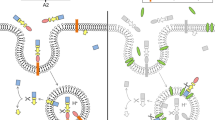Abstract
Targeted toxins are promising anticancer agents that allow selectively destroying cancer cells due to the increased content of onco-specific markers on their surface. The use of such anti-cancer toxins in medicine is mainly hampered by their high non-specific toxicity, in particular, hepatotoxicity. In our work on human cell line, we have shown that the removal of the DARPin-PE40 translocation toxin domain leads to a decrease in hepatotoxicity. The same effect is also observed when inactivation of the furin cleavage site in the DARPin-PE40 molecule was done. Simultaneous removal of both the translocation domain and the furin cleavage site showed the best results. This toxin modification can be used to create more selective anti-cancer toxins.

Similar content being viewed by others
REFERENCES
Allahyari, H., Heidari, S., Ghamgosha, M., et al., Immunotoxin: a new tool for cancer therapy, Tumour Biol., 2017, vol. 39, no. 2, p. 1010428317692226. https://doi.org/10.1177/1010428317692226
Bokori-Brown, M., Metz, J., Petrov, P.G., et al., Interactions between pseudomonas immunotoxins and the plasma membrane: implications for CAT-8015 immunotoxin therapy, Front. Oncol., 2018, vol. 8, p. 553. https://doi.org/10.3389/fonc.2018.00553
Weldon, J.E., Xiang, L., Chertov, O., et al., A protease-resistant immunotoxin against CD22 with greatly increased activity against CLL and diminished animal toxicity, Blood, 2009, vol. 113, no. 16, pp. 3792–3800. https://doi.org/10.1182/blood-2008-08-173195
Sokolova, E., Proshkina, G., Kutova, O., et al., Recombinant targeted toxin based on HER2-specific DARPin possesses a strong selective cytotoxic effect in vitro and a potent antitumor activity in vivo, J. Control. Release, 2016, vol. 233, pp. 48–56. https://doi.org/10.1016/j.jconrel.2016.05.020
Sokolova, E., Shilova, O.N., Kiseleva, D.V., et al., HER2-Specific Targeted Toxin DARPin-LoPE: immunogenicity and antitumor effect on intraperitoneal ovarian cancer xenograft model, Int. J. Mol. Sci., 2019, vol. 20, no. 10, p. 2399. https://doi.org/10.3390/ijms20102399
Glinka, E.M., Edelweiss, E., Sapozhnikov, A.M., et al., A new vector for controllable expression of an anti-HER2/neu mini-antibody-barnase fusion protein in HEK 293T cells, Gene, 2006, vol. 17, no. 366, pp. 97–103. https://doi.org/10.1016/j.gene.2005.06.042
Donato, M.T., Jover, R., and Gomez-Lechon, M.J., Hepatic cell lines for drug hepatotoxicity testing: limitations and strategies to upgrade their metabolic competence by gene engineering, Curr. Drug Metab., 2013, vol. 14, no. 9, pp. 946–968. https://doi.org/10.2174/1389200211314090002
Guo, L., Dial, S., Shi, L., et al., Similarities and differences in the expression of drug-metabolizing enzymes between human hepatic cell lines and primary human hepatocytes, Drug Metab. Dispos., 2011, vol. 39, no. 3, pp. 528–538. https://doi.org/10.1124/dmd.110.035873
Oberg, H.H., Kellner, C., Gonnermann, D., et al., Tribody [(HER2)2xCD16] is more effective than Trastuzumab in enhancing γδ T cell and natural killer cell cytotoxicity against HER2-expressing cancer cells, Front. Immunol., 2018, vol. 19, no. 9, p. 814. https://doi.org/10.3389/fimmu.2018.00814
Funding
The study was supported by the Russian Foundation for Basic Research (project no. 18-04-00212 A). Work on the isolation and purification of targeted toxins was supported by the Russian Science Foundation (project no. 19-14-00112). Work of E.V. Konovalova was supported by the Russian Foundation for Basic Research (project no. 183400899 mol-a).
Author information
Authors and Affiliations
Corresponding author
Ethics declarations
The authors declare that they have no conflict of interest. This article does not contain any studies involving animals or human participants performed by any of the authors.
Additional information
Translated by M. Batrukova
Rights and permissions
About this article
Cite this article
Khodarovich, Y.M., Konovalova, E.V., Schulga, A.A. et al. Removal of the Translocation Domain and the Furin Cleavage Site Decreases the Relative Hepatotoxicity of the Targeted Antitumor Toxins. Dokl Biochem Biophys 489, 370–372 (2019). https://doi.org/10.1134/S1607672919060048
Received:
Published:
Issue Date:
DOI: https://doi.org/10.1134/S1607672919060048




